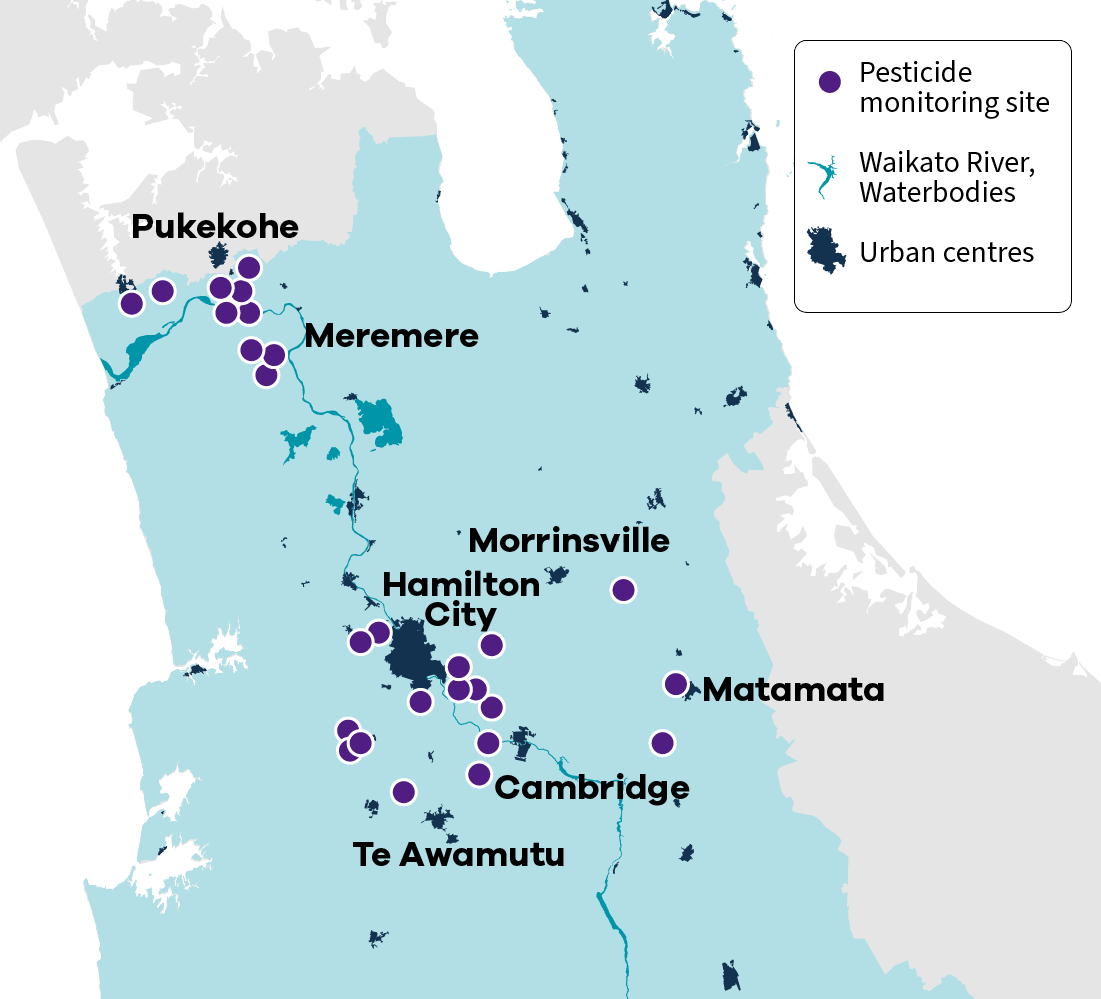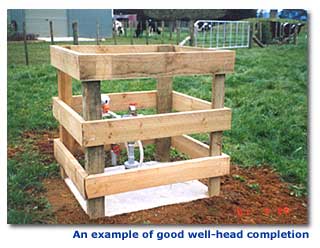Pesticide contamination of groundwater
Pesticides are contaminating some of our region’s groundwater supplies. Pesticides detected are usually at low concentrations, well below drinking water guidelines. The types of pesticide found reflect local land uses, both past and present. Careful pesticide selection and management is required to avoid contaminating groundwater.
A growing problem
Pesticide use in New Zealand has grown significantly in recent years. A total of 669 pesticides containing 302 different active ingredients were registered for use in New Zealand in 1995. The same year about 4,000 tonnes of pesticides were used across the country.
Large quantities of pesticides (including herbicides, insecticides and fungicides) are used in the Waikato region. From 1985 to 1987 about 500 tonnes of pesticide were used in the Waikato region annually.
Pesticide contamination of soils and waterways affects:
- our health
- our environment
- access to overseas markets (many of our international markets want to know their food is produced in an environmentally responsible way).

Pesticides on the move
Where pesticides end up in our environment depends on many factors:
- the pesticide’s chemical properties
- the type of soil (for example, the amount of organic matter)
- the local climate (sunlight and rainfall)
- how people use pesticides (when, where, how often).
Most pesticides break down at the ground surface or in shallow soil. However, some are reaching and contaminating our groundwater. Pesticides most likely to contaminate groundwater:
- last a long time - they don’t break down very easily
- dissolve easily in water
- travel easily through soil.
Shallow aquifers with only limited protection from soil are most vulnerable to contamination.
Contamination sources
Most pesticide contamination of groundwater is a result of poor management practices. Contamination may result from:
- excessive pesticide use
- storing or mixing pesticides too close to a well
- chemical use on neighbouring properties
- pesticides used many years ago that have not broken down (persistent).
Aquifers located under land used for cultivation are more likely susceptible to be contaminated. Cultivated soils often have:
- high levels of pesticides
- less organic matter to slow down the movement of pesticides to groundwater
- less bacteria present to break down pesticides.
What we have found
From 1996 to 1999 Environment Waikato studied the extent of pesticide contamination in the region’s groundwater. Samples were taken from 35 wells in two areas where pesticides are regularly used:
- Pukekohe/Pukekawa
- Hamilton Basin/southern Hauraki Plains.
The study focused on shallow aquifers lying under free draining soil, which are vulnerable to pesticide contamination, and where pesticides are in common use. This meant that we were studying a ‘worst case’ scenario.
Our study found pesticide residues in nearly three-quarters of the 35 wells sampled. A total of 20 different compounds were detected. The most common were:
- atrazine
- alachlor
- diuron
- procymidone.
Residue concentrations were generally well below the maximum accepted values (MAV) set for drinking water in New Zealand and Australia. A notable exception was dieldrin, which was much higher than the MAV.
| Pesticide | Sites found (out of 35) |
Maximum concentration as percentage of MAV1 |
| Dieldrin | 2 | 300 |
| Diuron | 6 | 48 |
| Metolochlor | 1 | 45 |
| Atrazine | 5 | 19 |
| Alachlor | 7 | 18 |
| Simazine | 3 | 7 |
| Picloram | 3 | 1 |
| Terbuthylazine | 2 | <1 |
| Procymidone | 5 | <1 |
| Metribuzine | 3 | <1 |
| 2,4–D | 1 | <1 |
| Oryzalin | 1 | <1 |
| Hexazinone | 1 | <1 |
| Triclopyr | 1 | <1 |
| Bromacil | 2 | <1 |
| Oxydiazon | 1 | <1 |
| Pirimisulfuron | 1 | <1 |
Our study showed only a small number of all pesticides used in the region were actually found in the groundwater. This suggests that most, particularly modern, pesticides do not pass through the soil into the aquifers below.
What’s being done
Waikato Regional Council is working with Crown Research Institutes, looking at how pesticides travel through different soil types and the likelihood they will contaminate groundwater supplies.
Many industry groups are working to reduce pesticide use. Some apple and kiwifruit growers are monitoring pest numbers in their orchards and only using pesticides when pest numbers increase past a certain number. Reduced pesticide use saves money and is better for the environment.
For policy information on pesticides check out our Regional Plan and our Regional Policy Statement.
How you can help
 Remember, it is much easier to prevent groundwater contamination than to fix it later!
Remember, it is much easier to prevent groundwater contamination than to fix it later!
- Don’t risk contaminating your water supply by storing, mixing or using chemicals too close to a well or bore.
- Make sure your well is sealed (for example with a concrete pad around the casing) to prevent contaminants entering into your aquifer.
- Always follow the recommended application rates and methods, and storage and disposal practices. Efficient pesticide use avoids waste and can save money.
Guidelines on pesticide use are contained in Growsafe, the New Zealand Standard for Agrichemical Users’ Code of Practice.
Learn more in our indicators that measure groundwater quality in the Waikato region, including nitrate and pesticide levels.




To ask for help or report a problem, contact us
Tell us how we can improve the information on this page. (optional)